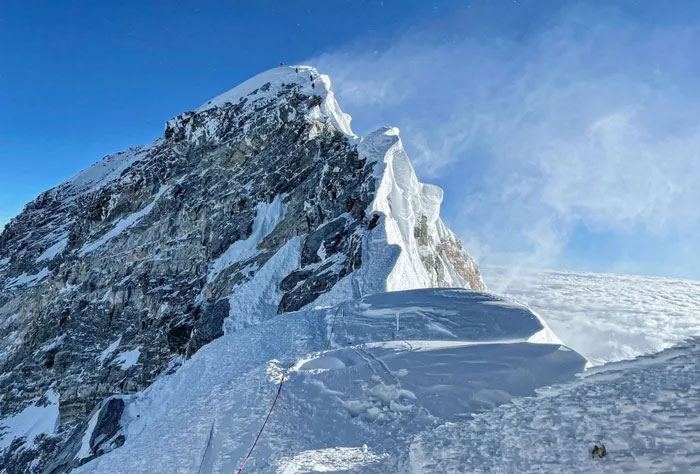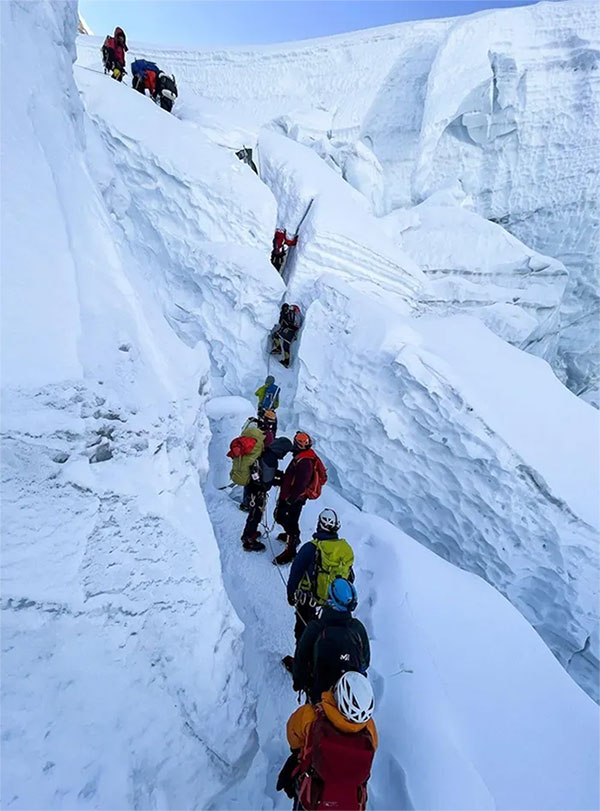Why is Mount Everest so attractive to so many people?
Dense, gloomy clouds filling the sky, cold winds carrying blizzards at speeds of more than 100 miles per hour, frigid temperatures of -30 degrees F leading to life-threatening avalanches that frequently occur are among the conditions. Typical on the world's highest mountain: Mount Everest. The massive 8,849 meter mountain lies between Nepal and Tibet in the Himalayas, with its peak surpassing most clouds in the sky.
Work hard to achieve your dreams
The attempt to climb Mount Everest requires months, sometimes years of training, but even with these factors in place, reaching the summit is not guaranteed. In fact, more than 300 people were confirmed dead on the mountain.
However, the mountain still attracts hundreds of climbers determined to conquer the peak every spring. So what drives some climbers to conquer the world's highest peak?

Climbers climb the Hillary Step during their southern ascent to Mount Everest. (Source: AFP.)
Dr Jacob Weasel, a trauma surgeon who successfully conquered Mount Everest last May after nearly a year of recovery, shared: 'I trained by wearing a 50-pound backpack and climbed stairs for two hours without any problems. So I think I'm in pretty good shape. However, in reality, I discovered that my physical strength was not suitable for the inherent challenges of the mountain.
'I took five steps and it took 30 seconds to a minute to catch my breath ,' said Dr. Weasel, recalling his struggle with hypoxia while climbing Mount Everest.

Journey to Mount Everest. (Source: AFP).
Climbers who want to reach the top often practice acclimatization to adjust their lungs to decreasing oxygen levels as they ascend the mountain. The process involves climbers ascending to one of four designated camps on Everest and staying there for one to four days before turning back down. This routine is repeated at least twice to allow the body to adapt to reduced oxygen levels. It increases a climber's chances of survival and summit success.
'If you took someone up and dropped them off at a base camp on Mount Everest, not even the top one, they would probably go into a coma within 10 to 15 minutes. They will die within an hour because their bodies cannot adjust to such low oxygen levels,' Mr. Weasel said.
Although Dr. Weasel has successfully conquered dozens of mountains, including Kilimanjaro (19,341 ft), Chimborazo (20,549 ft), Cotopaxi (19,347 ft) and most recently Aconcagua (22,837 ft) in January of this year, But he said, no mountain can compare with the height of Mount Everest.
At its highest altitude, Everest is virtually incapable of sustaining human life, and most climbers use supplemental oxygen above 23,000 feet. A lack of oxygen poses one of the biggest threats to climbers attempting to reach the summit, with oxygen levels dropping below 40% as they reach Everest's 'death zone'.

Climbers' tents are set up at Everest base camp. (Source: AFP).
Great survival instinct
The climbers' first target was Everest base camp at an altitude of about 5,182 meters, which took the climbers about two weeks to reach. They then continued on to the remaining three camps arranged along the mountain.
The final four camps before the summit, located along the edge of the dead zone at 7,925 meters, expose climbers to an extremely thin layer of air, sub-zero temperatures and high winds strong enough to blow away a person off the mountain.
'It's hard to survive there,' Dr. Weasel told CNN. High-altitude cerebral edema (HACE) is one of the most common illnesses experienced by climbers attempting to reach the summit. HACE causes the brain to swell as it tries to regain a steady supply of oxygen, causing drowsiness and difficulty speaking and thinking. This symptom is often accompanied by blurred vision and sporadic delusional episodes.
'I hallucinated when I heard a voice that I thought was coming from behind me. I even saw the faces of my children and my wife coming out of the rocks ,' Dr. Weasel shared.

Climb Mount Everest. (Source: AFP).
According to Alan Arnette, a climbing instructor who conquered Everest in 2014, when a fellow climber is seriously injured or dies on the mountain, you will have to leave them behind if you cannot save them. 'What most climbing teams do out of respect for the climber is they will move the body out of sight (if possible)' , Mr Arnette said.
According to the climbing instructor, seeing dead people on Everest is comparable to seeing a horrific car accident. It's been 10 years since the deadliest accident on the world's highest mountain, after an avalanche killed 12 Sherpa guides. And 2023 is set to be the deadliest year on Everest, with 18 people killed on the mountain – including five who remain unidentified.
Helicopter search and rescue missions are challenging due to altitude and often dangerous conditions, leading to some rescuers dying trying to save others.
Despite the danger, climbers still aspire to conquer Mount Everest because they will be able to watch the sun rise from a height of nearly 8,849 meters and the shadow of Mount Everest shining on the valley below. 'This is probably one of the most beautiful things I've ever seen in my life. I have never felt so small' , Dr. Weasel shared.
- It seems that the height of Mount Everest has suddenly changed
- Learn interesting things about Mount Everest
- The UFO suddenly appeared at Mount Everest, making science a headache
- Mortality rate on Mount Everest
- Why do people always want to conquer Mount Everest?
- The magic beauty of 'the roof of the world'
- Mount Everest moved after Nepal earthquake
- Clearing garbage on Mount Everest
- Mount Everest is the highest in the world, true or false?
- According to this measure, Everest is not the highest mountain in the world
- China built seismic station at Mount Everest
- Video: The collision created the Everest
 'Fine laughs' - Scary and painful torture in ancient times
'Fine laughs' - Scary and painful torture in ancient times The sequence of numbers 142857 of the Egyptian pyramids is known as the strangest number in the world - Why?
The sequence of numbers 142857 of the Egyptian pyramids is known as the strangest number in the world - Why? History of the iron
History of the iron What is alum?
What is alum?